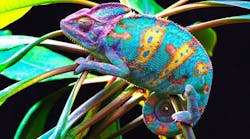Chameleon-inspired 3D printing technique uses one ink to print different colors, including red, gold, and green
The natural world is the greatest source of inspiration for engineers, designers, and creators alike. So far, I’ve showcased robots that can roll up like pangolins and swim through the ocean like jellyfish. Now it’s the chameleon’s time to shine. These lizards offer an array of unique and practical features, including a long, sticky tongue to catch insects and eyes that can move independently of each other. However, chameleons are best known for their ability to change color. According to the San Diego Zoo, chameleons have four layers of skin, and three of the layers contain or reflect different colors. The chromatophore layer has yellow and red pigments, the melanophore layer can create brown and black colors or reflect blue, and the nether layer reflects white. The color changes we see are caused by nerve impulses and hormone changes that force the color cells in these layers to expand and shrink. Cool, right? Now imagine if we could use these principles to revolutionize the 3D printing process.
Researchers at the Beckman Institute, which fosters collaborative, interdisciplinary research among the University of Illinois faculty, have done just that. The team has created a new 3D printing process that allows for the altering of structural color during the printing process. The UV-assisted direct-ink-write 3D printing approach can create an array of vibrant, sustainable colors in the visible wavelength spectrum from blue to orange using only one ink. The process works by tuning light to control evaporative assembly of specially designed crosslinking polymers.
The research team published their paper, “Direct-ink-write cross-linkable bottlebrush block copolymers for on-the-fly control of structural color,” in PNAS earlier this month. In an excerpt from the paper’s abstract, the team writes: “By marrying additive manufacturing with self-assembly, we develop a UV (ultra-violet)-assisted direct ink write approach for on-the-fly modulation of structural color by programming the assembly kinetics through photo-cross-linking. We design a photo-cross-linkable bottlebrush block copolymer solution as a printing ink that exhibits vibrant structural color (i.e., photonic properties) due to the nanoscopic lamellar structures formed post extrusion. By dynamically modulating UV-light irradiance during printing, we can program the color of the printed material to access a broad spectrum of visible light with a single ink while also creating color gradients not previously possible.”
In a recent quote, Sanghyun Jeon, the lead author of the paper, said, “Unlike traditional colors which come from chemical pigments or dyes that absorb light, the structural colors abundant in many biological systems come from nano-textured surfaces that interfere with visible light. This makes them more vibrant and potentially more sustainable.”
The Lighter Side of Manufacturing
Created by the editors of Plant Services and New Equipment Digest, The Lighter Side of Manufacturing is a feel-good blog that showcases how advances in science, math, engineering, and technology are making our world more whimsical. Here’s another post that is guaranteed to brighten your day.
3D Printing Experiment Creates 15-Pound Bike That Rivals Professional Bikes
CoreTechnologie's 3D printing project ended up creating an aluminum and carbon bike that clocks in at the lowest possible weight limit for bikes in the Tour de France—showing the ease of creating complex consumer items with the technology.
